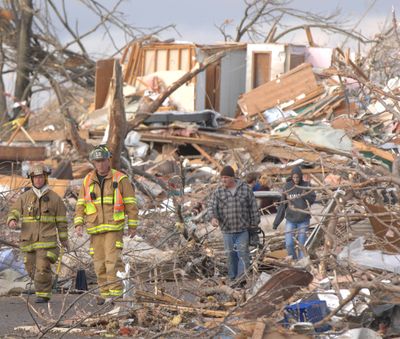Tornadoes tear through Illinois, killing at least six

WASHINGTON, Ill. – Dozens of tornadoes and intense thunderstorms swept across the Midwest on Sunday, leaving at least six people dead and unleashing powerful winds that flattened entire neighborhoods, flipped over cars and uprooted trees.
Illinois took the brunt of the fury as the string of unusually powerful late-season tornadoes tore across the state, injuring dozens and even prompting officials at Chicago’s Soldier Field to evacuate the stands and delay the Bears’ football game.
“The whole neighborhood’s gone. The wall of my fireplace is all that is left of my house,” said Michael Perdun, speaking by cellphone from the hard-hit central Illinois town of Washington, where he said his neighborhood was wiped out in a matter of seconds.
“I stepped outside and I heard it coming. My daughter was already in the basement, so I ran downstairs and grabbed her, crouched in the laundry room and all of a sudden I could see daylight up the stairway and my house was gone.”
An elderly man and his sister were killed when a tornado hit their home in the rural southern Illinois community of New Minden, coroner Mark Styninger said. A third person died in Washington, while three others perished in Massac County in the far southern part of the state, said Patti Thompson of the Illinois Emergency Management Agency. She did not provide details.
With communications difficult and many roads impassable, it remained unclear how many people were killed or hurt. The Illinois National Guard said it had dispatched 10 firefighters and three vehicles to Washington to assist with immediate search and recovery operations.
In Washington, a rural community of 16,000, whole blocks of houses were erased from the landscape, and Illinois State Police Trooper Dustin Pierce said the tornado cut a path from one end of town to the other, knocking down power lines, rupturing gas lines and ripping off roofs.
An auto parts store with several people inside was reduced to a pile of bricks, metal and rebar; a battered car, its windshield impaled by a piece of lumber, was flung alongside it. Despite the devastation, all of the employees managed to crawl out of the rubble unhurt, Pierce said.
“I went over there immediately after the tornado, walking through the neighborhoods, and I couldn’t even tell what street I was on,” Washington Alderman Tyler Gee told WLS-TV. “Just completely flattened – some of the neighborhoods here in town, hundreds of homes.”
At OSF Saint Francis Medical Center in Peoria, spokeswoman Amy Paul said 37 patients had been treated, eight with injuries ranging from broken bones to head injuries. Another hospital, Methodist Medical Center in Peoria, treated more than a dozen, but officials there said none of them were seriously injured.
Steve Brewer, Methodist Medical Center’s chief operating officer, said doctors and other medical professionals were setting up a temporary emergency care center to treat the injured before transporting them to hospitals, while others were dispatched to search through the rubble for survivors.
By nightfall, Trooper Pierce said, there were reports of looting in Washington.
About 90 minutes after the tornado destroyed homes in Washington, the storm darkened downtown Chicago. As the rain and high winds slammed into the area, officials at Soldier Field evacuated the stands and ordered the Bears and Baltimore Ravens off the field. Fans were allowed back to their seats shortly after 2 p.m., and the game resumed after about a two-hour delay.
Just how many tornadoes hit was unclear. According to the National Weather Services website, 65 tornadoes had struck, the bulk of them in Illinois. But meteorologist Matt Friedlein said the total might fall because emergency workers, tornado spotters and others often report the same tornado.
Still, when the weather service was issuing its warning that severe weather was bearing down on the Midwest, officials said the last such warning issued so late in the season in November came in 2005, and the result was an outbreak of 49 tornadoes.
The storm followed warnings by the weather service that the system was simply moving too fast for people to wait until they saw it to get ready.
“This is a very dangerous situation,” said Russell Schneider, director of the weather service’s Storm Prediction Center. Some 53 million people in 10 states were “at significant risk for thunderstorms and tornadoes,” he said.
The storm also slammed through parts of Wisconsin, Indiana, Michigan, Ohio and Kentucky as it made its way east into the mid-Atlantic states on Sunday night. Tornadoes, large hail and damaging winds tore through several communities, leaving thousands without power as emergency crews tried to clear roads.
Friedlein said such strong storms are rare this late in the year because there usually isn’t enough heat from the sun to sustain the thunderstorms. But he said temperatures Sunday were expected to reach into the 60s and 70s, warm enough to help produce severe weather when it is coupled with winds, which are typically stronger this time of year than in the summer.
“People can fall into complacency because they don’t see severe weather and tornadoes, but we do stress that they should keep a vigilant eye on the weather and have a means to hear a tornado warning because things can change very quickly,” Friedlein said.